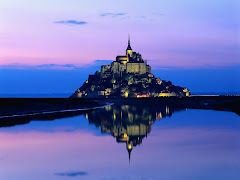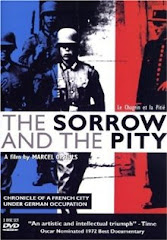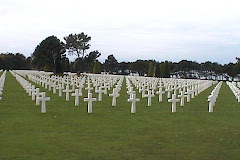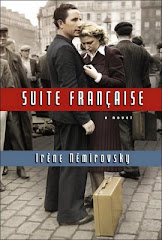This afternoon, I went with one of my colleagues on a boat cruise down the canals that connect Caen with the Atlantic Ocean at Ouistreham. It cost thirteen Euros and I think it was the greatest deal that I have received. The weather was gorgeous and the sun was shining. There was a beautiful breeze and the boat cruise was nearly three hours and brought us to the Ocean and back. While going down and coming back, there was a running commentary about the history of various sites and areas. This aspect was an added bonus as I learned a great deal. We even passed by Pegasus Bridge which was a fierce battle of the D-Day invasion. A truly amazing day was had and I was able to soak up some sun too!
dimanche 26 juillet 2009
Sundays in France
In France, Sundays are still the day of rest for 95% of the population. Places like Paris still have a bit of life but outside of the tourist spots most of France closes up shop (literally) on Sunday and if they may be open on Sunday, don't expect the shop to be open on Monday. With that in mind, today I decided to spend the day a la francais. I slept in a bit and decided that I would go to the Sunday markets at St. Pierre and Port de Plaisance. I should have given myself more time because I arrived at 10:30am and needed to meet someone at 1:30. Believe it or not, it really was not enough time. This market was gigantic and had every product known to man. Vendors selling; giant paellas, couscous meals prepared to order, every fresh vegetable known to man on every other vendor's table were just a few. Not to forget; clothing from babies to what was labeled "grande taille" big sizes, Arabic and Indian movies, halal butchers, fresh rotisserie cooked chickens, cured hans, homemade sausages and cured meats, more cheeses than I knew existed, brick-oven pizza vendors, Vietnamese and Asian food vendors, and so much more I do not have enough space to list it all. It was truly a sensory experience and the French certainly have figured some things out that Americans are really losing out on. I would love to go to these types of markets regularly in order to buy local and know exactly from where my food is coming.
Wars
Yesterday, I spent a great deal of time (over 3 hours) in Caen Memorial (Cite de l'histoire contemporaine) across the street. It has visitors everyday and is one of the only places around that is open 7 days a week without a day off (save holidays). We have out classes there as there is a great reference library on the 20th century and meetings rooms that one can use with film-viewing facilities. It has been great to go there each day, I toured the special exhibit at the beginning of our stay here in Caen called Survivre and tells the tales of children in the Holocaust. It is an extensive exhibit that chronicles the children before, during, and after the Holocaust (known in France as La Shoah). It was a pretty sobering exhibit but fascinating to see the lengths to which we go as a society to repress one another, children included. I spent about 2 hours there so I guess you could say that these museums are pretty packed.
I visited the main part of the museum on Saturday that chronicles World War II. They do a great job in preparing the scene, talking about what led up to the war and the reasons why. As you go through this spiraled hall, you descend into the war both figuratively and literally. As you walk through the exhibits, you are able to see the good, the bad, and the ugly. It features Vichy and its regime, the Jewish question and Final solution, the war and D-Day, and the Resistance. Amazing to go through all of this information. At the end of the exhibit, a film is shown to help understand D-Day created with actual footage from the "debarquement" and truly shows the horror that these men met head on. The film was a sobering reminder of the simple carnage of human life during this endeavor.
I was also able to go to another film after that called Esperance (Hope). This film with very few words went through the conflicts of the 20th century. World War II, the Cold War, Easterb bloc invasions, Afghanistan and the russians, famine in Africa, poverty in Latin and south America, Cuban Missile Crisis, Berlin Wall and much more. The film is a montage of everything and it concludes in an impressive way, Dr. Martin Luther King making his speech at the Lincoln Memorial and the suggestion that the only thing we really have to hold onto throughout these conflicts is HOPE!
With that in mind, I realized an important aspect of the French the other day. I have been exploring the concepts of World War II and the dark years of occupation and liberation. The French experienced tremendous loss. Just during the 100 days of liberation (D-Day invasion and beyond), there were hundreds of thousands of civilian casualties not counting the military. Caen, alone, was annihilated with eighty percent of the city destroyed. Save for Pearl Harbor and September 11, American really have not had to experience a level of destruction on such a large scale. Even with those 2 events, I do not think we really can understand what it is like as the major western European nations did in the two World Wars. With this thought in mind, I began to connect some political issues. George W. Bush (you all know how much I love him!) vilified the French for not supporting the war in Iraq and not joining the "coalition" of nations. Many went as far as changing names of foods (Freedom Fries and Freedom Toast) and boycotting the French foods that many of us appreciate. Years later, I think the French do not really regret their decision as we are mired in conflict on two fronts. Seeing photos of the destruction that France experienced, I understand their mindset with regards to war. Not quick to rush into war would have been an interesting lesson for us to learn. Are we truly living in a safer world because we committed ourselves to war? I think you all know my response to that question. Just an interesting reflection during my experience here in Caen.
samedi 25 juillet 2009
A little more traveling....
We were given Thursday and Friday to work on our projects as our presentations are on Monday and Tuesday. I cheated a bit with a few others in the group and we took a bus tour to Avranches, Villedieu les poeles, and best of all Mont Saint Michel. The two towns were quite nice. Villedieu is know for its copper making and bell forges. Pretty neat to see the way they actually make bells, it is quite an old process that they still keep alive today. Avranches had a beautiful botanical garden that was a nice stop and it provided us with a beautiful panoramic view of the coastline and Mont Saint Michel.
I am quite happy that I parted with my thirty-two Euros because I had the experience of a lifetime at Mont Saint Michel. It served as a church ever since the Romanesque monastery was built 1000 years ago. It grew up around this high point that at high tide becomes an island. It was interesting to see this island with so much to offer. As you climbed the narrow streets (no more than 8 feet across), there were restaurants and shops lining the streets. You are required to climb a good deal but the actually abbey is well worth the climb. The line was a pretty extensive one as this site is the second most visited place in France for both the French and tourists next to Paris. It was interesting to find out that the abbey was used as a prison during the 1789 Revolution when the religious brothers were thrown out of this location. However, it has been restored to a Benedictine monastery. We were lucky enough to see the noon service of the sisters and brothers on our tour.
It is truly one of the most beautiful places that I have ever seen. An interesting tidbit of information, there is only one road that leads up to the island but it is causing issues with the tides and shoreline. The plan is to demolish the road and put the site back to its natural setting and shuttle people from one meeting point. One wonders why they could not walk??? I have the answer, there is too much quicksand (sable mouvant) around the island and people particularly in the Middle Ages when they were doing their pilgrimage to the site, lost their lives trying to cross in low tide. Interesting factoid!
vendredi 24 juillet 2009
Dora Bruder
We discussed a fascinating book this week, Dora Bruder by Patrick Modiano (any of my AP students, you may be getting this book to read). Modiano is an archivist and historian who has written extensively on many aspects of history. The book/novel (this concept is debated) is personal journey for Modiano. He was reading an article in Paris Soir from 1941 and he stumbles onto a small advertisement imploring the public's help in finding a girl named Dora Bruder. Her parents, Ernest and Cecile put this piece in the newspaper in order to find their daughter. They had attempted to hide her in a Catholic school that boarded students, although she was a young Jewish girl, her parents believed that she may be safer there.
Modiano spins a tale of trying to find information about Dora and her past. He spends years going through long-forgotten documents and books to find more about this young girl who seemingly disappeared off of the face of the earth. As he begins to piece together small tidbits of her life, he weaves his own life experiences into those of Dora's. As you read the book, you want to know more about this girl. It is eventually discovered that Dora does make it back home but is eventually deported to Auschwitz where she perishes. Modiano discovers additional information about her life but many details of her life remain private. Modiano contends that these most precious parts of Dora remained her own and unknown to the public. I read this book and it required me to reflect a great deal.
Modiano gave a voice to this one young girl, therefore Dora will not be forgotten. How many millions of others will go on into the great unknown never had the opportunity to regain their voices. How interesting it must be to put together what was a very scattered jigsaw puzzle, known as Dora Bruder's life. A great read, check it out!
dimanche 19 juillet 2009
Oh the history...
We had the past three days off from class and this fact meant that a little touring was in order. On Friday, I took a leisurely day in the morning and in the afternoon, I visited the chateau Ducal in Caen. This castle, one of many built by William the Conqueror, is nearly one thousand years old. It houses the Musee de Normandie and I was also able to visit a special exhibit about the Gaul's presence in Caen and the Normandy region. There were burials with skeletons and various remains of this civilization from the Bronze Age up through the Roman occupation. These relics and pieces date back over 2000 years and some more than 3500 years. The history that exists in Europe is truly one of its most amazing assets. Just to be on the ramparts of the castle and look through the various archery windows and think about what it must have taken to build this castle is overwhelming.
On Saturday, a group of individuals from our seminar ventured to Bayeux, France. Famous for the Bayeux tapestry that was displayed once a year in the cathedral at the city center. we toured the tapestry which is 70 meters in length. It is hand embroidered and has been the subject of many historical questions. The shear fact that this tapestry is nearly 1000 years old is astounding. As you walk around the piece, a narration gives you a blow by blow story of the Battle of Hastings and the events that lead up to the war. Great thanks to William the Conqueror because if he did not win the war in 1066, we English speakers would be much more Germanic in our approach to the English language, thus our language is greatly influenced from the French language. I digress, the most amazing thing is to simply be in the presence of such an amazing piece of history. We strolled through the city and in doing so had a great conversation with a 94 year old man who was a soldier during the second World War and served five years in a Prisoner of War camp in Germany. He was really like a walking history book and extremely welcoming of Americans and the fact that we spoke French didn't hurt either.
Today I thought was going to be a wash, however I started my day finally and on a whim visited the Abbaye aux Hommes, which was again built by William the Conqueror. This site is where he is buried as well. This abbey was built along with the Abbaye aux Dames in order to bribe the pope at the time to allow him to marry his love, Mathilde. The pope forbade it at first but after these two abbeys were constructed and given to the church, he consented (such a nice guy)! I should not leave out that Mathilde was Williams cousin, an interesting tidbit. The originally abbey dates from the 1080's and therefore it is itself nearly one thousand years old. It is now the hotel de ville (town hall) and is pretty amazing in its architecture. The tours are free on Sunday so this was a win-win on all accounts.
While I am here to study World War II and the legacy of the dark years, it was a great experience to take a journey back in time in order to visit these beautiful places. It turned out to be overall good weather. It rains from time to time but just as quickly as the rain comes, it goes and the sun shines again. I was able to live history this weekend and it pretty amazing!
samedi 18 juillet 2009
Movies
This week has been interesting in class. We have studied three films dealing with World War II and the Resistance / Collaboration issues that arose in France. The first, Le Chagrin et La Pitie (The sorrow and the pity), was a ground-breaking documentary by Marcel Ophuls released in May 1968. As our seminar leaders put it, it is "a film which exposed not only the complex realities of the period but the less-than-admirable attitudes and actions of many of the French," forever shattering the Gaullist memory of great resistance. In addition, we viewed Lacombe, Lucien a film by Louis Malle released in 1974. A fascinating film that looks at the complexities of one person's struggle during the period of Occupation. While I am not a big fan of Lucien's, I thought the movie was excellent and really provided for an intense conversation amongst seminar participants. Finally, on Thursday (7/16) we viewed Lucie Aubrac a film released in 1997 directed by Claude Berri. This movie was interesting in that it provides a glorified view of the Resistance movement. Lucie and Raymond Aubrac were members of the Resistance, but in recent years have been challenged on their recounting of the memories. While the movie is a bit fantastic, it is worth a look to simply see the other side of the "coin" where the French were fighting back to regain their nation's sovereignty.
The Beaches
A few days ago, our group spent two days doing a whirlwind tour of many places significant in the D-Day (Jour-J en francais) Invasion. We visited three different cemeteries in the area (German, British and American). These three locations were quite striking to say the least. We traveled to both Utah and Omaha Beaches, the German "batterie" where their gun bunkers were constructed. At this site, you can walk around to look at the guns and defenses where the Germans tried to defend the coast from the invasion. In addition, you can still see the bombing areas where there are giant holes, it is pretty evident why this war too such a toll on Europe. In addition, we toured the World War II museum at Bayeux and saw a pretty amazing film at Arromanche that gave a 360 degree account of the war. We traveled to St. Mere Eglise where the Allies parachuted soldiers into the town to offer a distraction to the Germans in order to assist the seaside invasion. One of the most intriguing sites was the artificial port created by the Allies once they captured this area. Not having a natural port, the closest one being Cherbourg occupied by the Nazis, they were forced to create their own. Amazingly enough, there are still parts of this port that are still in the water off of the shore. Looking at pictures in the museums is astounding, you are immediately impressed by the ingenuity of the Allies and what a feat it was to construct this man-made port.
These experiences were certainly once in a lifetime opportunities. However, I could not help but thinking about how peaceful these areas are now. Omaha and Utah beaches were gorgeous. The sun was shining, you can walk along for huge stretches and they are idyllic locations. With this peaceful reflection, you are at once smacked with the reality that happened 65 years ago on these beaches. The peace was shattered by the Allied invasion to repel the Nazis. These men were at a huge disadvantage coming in from the water, in essence providing easy targets for the fortified Nazi army. However, against huge odds, the Allies prevailed and after reflecting on this sobering piece of history, you are thankful for the relative safety with which we are accustomed.
The cemeteries are another interesting talking point. The German cemetery is quite stark and very Stoic in its approaches. The British cemetery was beautiful and there is a very interesting monument at this cemetery speaking about the relations between England and France going back 1000 years to William the Conqueror. The American cemetery was fascinating in many respects. The beautiful gardens and symmetry are simply amazing. It is striking to see the thousands of grave markers. In walking through paying my respects, I was stunned to fall upon a boy of 20 years old killed on my birthday (7/15) almost 65 years to the day. I was truly struck by this reality. One of the most interesting reflections that I made after seeing all three sites was the fact that so many died, yes, but on both sides. How many of these people really had no specific ideologies one way or another? What were their stories on both sides? Thousands and thousands of lives, a full generation of American, Canadian, and European men lost. Who knows what great things may have come from those men if circumstances were different?
Inscription à :
Commentaires (Atom)





























